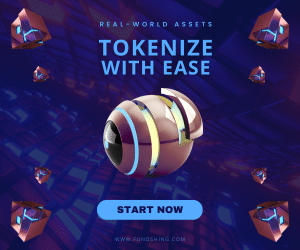An interview with Founder & CEO of Archax, Graham Rodford – part one
It takes time to establish a new industry, but Founder & CEO of Archax, Graham Rodford, is rock-solid confident that security tokens and the industry surrounding them are here to stay. The way forward, he believes, is to appeal to the big established industrial investors by developing solutions that enable them to utilize the advantages of tokenization within a fully compliant environment.
In this first part of the interview, Graham Rodford describes what he sees as the three primary advantages of tokenization.
In part two, he talks about Archax’ approach towards the traditional world of industrial investors and their view on asset tokenization. Also, he gives his opinion on the current market developments and claims that in not too long, we will start to see a consolidation of the currently much too many security token issuance platforms.
Michael Juul Rugaard (MJR): I just read a rather critical article by a guy called Andy Singleton in which he says: “Tokenization is pitched as an efficient way to securitize small deals, under $80M. However, it suffers from a deep underlying problem, which is that small-cap deals make bad security investments. They don’t consistently deliver profits for passive security buyers, and investors are not buying.”[1] Do you agree?
Graham Rodford (GR): No! I think the problem is that we are still really early on here. Many people talk about the benefits to digital securities, and yes, there are benefits, but they’re not necessarily ones from digital securities. So, for instance, when people talk about 24/7 trading, fractionalization and liquidity, they all may be true, but they’re not necessarily the reasons that we think that this new industry of asset tokenization is going to take off.
MJR: Okay, so what are the reasons?
Facilitating liquidity
GR: I think the way Archax sees the world, is that there are three main advantages to tokenization.
One is that it facilitates
liquidity. It doesn’t necessarily bring liquidity, but it gives you the
ability to trade something you may not otherwise be able to trade.

If we look up most of the digital security offerings that are out there at the moment, indeed, they’re not companies that you would have heard of. They tend to be illiquid assets mostly, and there’s an especially high proportion in real estate. Moreover, the reason for that, we think, is because that sort of asset has the most obvious benefits to it.
If you take a piece of real estate like the Shard in London, for example, it probably trades once every seven or eight years. It’s not that by putting it on a secondary market in digital security form, it’s suddenly going to trade 100,000 times a second. However, it does mean that if the owners want to crystallize any of their investments at any point, they can put it out on the market. So if somebody wants to own a piece of that real estate, they can buy that.
So as a result, for sure, the liquidity is not going to be any worse. However, if in the absence of that secondary market, that opportunity doesn’t even exist. So it facilitates liquidity. Also, this isn’t really a blockchain point; it’s more just by allowing these securities to be admitted to a market. So I don’t think that it’s going to bring liquidity, but I think by creating a secondary market, you will suddenly realize that there is demand for some liquidity there that you couldn’t see before because the market didn’t facilitate it.
MJR: So, if facilitating liquidity is the first advantage out of three, what is number two?
Access to capital markets
GR: The second is access to capital markets, and this isn’t necessarily a benefit of blockchain, but the fact that these markets have tended to be giving direct market access to everyone and across the border means that more people globally can access these opportunities.
If we look along most securities, the big listed companies, like the Apples and Amazons of this world, not only are they listed on the leading exchanges, pretty much every broker in the world will let you trade them and any one of us can access them through our pension funds or our ISAs or whatever it may be, whatever structured investment products we’ve got. However, smaller companies might be able to advertise in their shop window. Let’s say you’re a coffee shop in London, you could promote in your shop window, okay, we’re raising of mini-bond, or we’re raising equity, or you might be able to go on a crowdfunding platform. But the chances of being able to appeal to all potential investors globally is pretty unlikely.
Moreover, what we saw with the utility market was that there’s a lot of people globally that don’t mind investing in good investment opportunities if they can get access to them. You know, you’d never before would’ve thought that half of those companies would have appealed to anyone. So if you allow these companies to create digital securities and you can create them on a globally accessible secondary market, then, for sure, people will have an interest in them.
So the point is that some people, for SMEs especially, they go and list on markets like AIM, but most of us don’t have easy access to AIM stocks. However, if you can create a market where these SMEs can go and raise capital, you make them accessible to everyone, and potentially they have more access to more capital.
Effective financial services infrastructure
MJR: So, facilitating liquidity and allowing access to capital markets are the first two advantages of tokenization. What is the third?
GR: The final point, which, long term, is probably the most important one, is that this technology is one of the most effective ways to run a financial services infrastructure. So for the security itself, being able to efficiently run corporate actions, being able to look at your cap table, being able to do your reg reporting on the blockchain is more straightforward. If every transaction happens on the blockchain with digital securities, then the friction in the financial services market reduces dramatically. So that’s the reason why ultimately it will be adopted by everyone. So to sum up: You get the efficiencies, and you get access to capital markets. And furthermore, you get this facilitation of liquidity.
– End of part one-
[1] https://medium.com/hackernoon/fixing-the-80m-problem-with-tokenization-5893e658d3a1. Andy Singleton is not just critical; he suggests a ‘workaround’ which is a bundling of smaller deals.
Photo by Sebastian Bednarek on Unsplash
You Might also Like
























